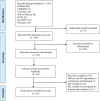Decoding machine learning in nursing research: A scoping review of effective algorithms
- PMID: 39294553
- PMCID: PMC11771615
- DOI: 10.1111/jnu.13026
Decoding machine learning in nursing research: A scoping review of effective algorithms
Abstract
Introduction: The rapid evolution of artificial intelligence (AI) technology has revolutionized healthcare, particularly through the integration of AI into health information systems. This transformation has significantly impacted the roles of nurses and nurse practitioners, prompting extensive research to assess the effectiveness of AI-integrated systems. This scoping review focuses on machine learning (ML) used in nursing, specifically investigating ML algorithms, model evaluation methods, areas of focus related to nursing, and the most effective ML algorithms.
Design: The scoping review followed the Preferred Reporting Items for Systematic Review and Meta-Analysis Extension for Scoping Reviews (PRISMA-ScR) guidelines.
Methods: A structured search was performed across seven databases according to PRISMA-ScR: PubMed, EMBASE, CINAHL, Web of Science, OVID, PsycINFO, and ProQuest. The quality of the final reviewed studies was assessed using the Medical Education Research Study Quality Instrument (MERSQI).
Results: Twenty-six articles published between 2019 and 2023 met the inclusion and exclusion criteria, and 46% of studies were conducted in the US. The average MERSQI score was 12.2, indicative of moderate- to high-quality studies. The most used ML algorithm was Random Forest. The four second-most used were logistic regression, least absolute shrinkage and selection operator, decision tree, and support vector machine. Most ML models were evaluated by calculating sensitivity (recall)/specificity, accuracy, receiver operating characteristic (ROC), area under the ROC (AUROC), and positive/negative prediction value (precision). Half of the studies focused on nursing staff or students and hospital readmission or emergency department visits. Only 11 articles reported the most effective ML algorithm(s).
Conclusion: The scoping review provides insights into the current status of ML research in nursing and recognition of its significance in nursing research, confirming the benefits of ML in healthcare. Recommendations include incorporating experimental designs in research studies to optimize the use of ML models across various nursing domains.
Clinical relevance: The scoping review demonstrates substantial clinical relevance of ML applications for nurses, nurse practitioners, administrators, and researchers. The integration of ML into healthcare systems and its impact on nursing practices have important implications for patient care, resource management, and the evolution of nursing research.
Keywords: artificial intelligence; machine learning; machine learning algorithms; performance validation; scoping review.
© 2024 The Author(s). Journal of Nursing Scholarship published by Wiley Periodicals LLC on behalf of Sigma Theta Tau International.
Conflict of interest statement
The authors declare no conflicts of interest.
Figures
Similar articles
-
Beyond the black stump: rapid reviews of health research issues affecting regional, rural and remote Australia.Med J Aust. 2020 Dec;213 Suppl 11:S3-S32.e1. doi: 10.5694/mja2.50881. Med J Aust. 2020. PMID: 33314144
-
Artificial intelligence assisted telehealth for nursing: A scoping review.J Telemed Telecare. 2025 Jan;31(1):140-149. doi: 10.1177/1357633X231167613. Epub 2023 Apr 18. J Telemed Telecare. 2025. PMID: 37071572
-
Artificial intelligence for breast cancer detection and its health technology assessment: A scoping review.Comput Biol Med. 2025 Jan;184:109391. doi: 10.1016/j.compbiomed.2024.109391. Epub 2024 Nov 22. Comput Biol Med. 2025. PMID: 39579663
-
Folic acid supplementation and malaria susceptibility and severity among people taking antifolate antimalarial drugs in endemic areas.Cochrane Database Syst Rev. 2022 Feb 1;2(2022):CD014217. doi: 10.1002/14651858.CD014217. Cochrane Database Syst Rev. 2022. PMID: 36321557 Free PMC article.
-
Artificial intelligence technologies and compassion in healthcare: A systematic scoping review.Front Psychol. 2023 Jan 17;13:971044. doi: 10.3389/fpsyg.2022.971044. eCollection 2022. Front Psychol. 2023. PMID: 36733854 Free PMC article.
Cited by
-
Machine Learning in Nursing: A Cross-Disciplinary Review.Cureus. 2025 Jul 2;17(7):e87181. doi: 10.7759/cureus.87181. eCollection 2025 Jul. Cureus. 2025. PMID: 40755696 Free PMC article. Review.
References
-
- Belur, J. , Tompson, L. , Thornton, A. , & Simon, M. (2021). Interrater reliability in systematic review methodology: exploring variation in coder decision‐making. Sociological Methods & Research, 50(2), 837–865. 10.1177/0049124118799372 - DOI
-
- Bharadwaj, H. K. , Agarwal, A. , Chamola, V. , Lakkaniga, N. R. , Hassija, V. , Guizani, M. , & Sikdar, B. (2021). A review on the role of machine learning in enabling IoT based healthcare applications. IEEE Access, 9, 38859–38890. 10.1109/access.2021.3059858 - DOI
Publication types
MeSH terms
LinkOut - more resources
Full Text Sources
Miscellaneous


